


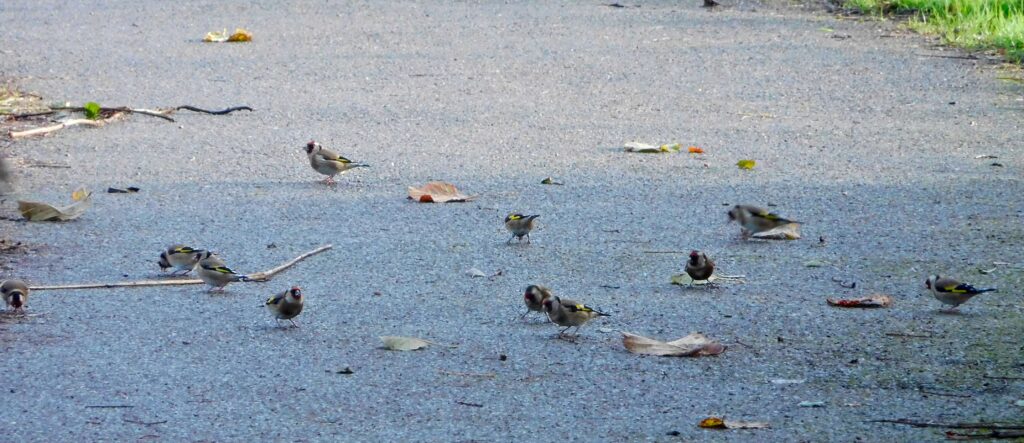
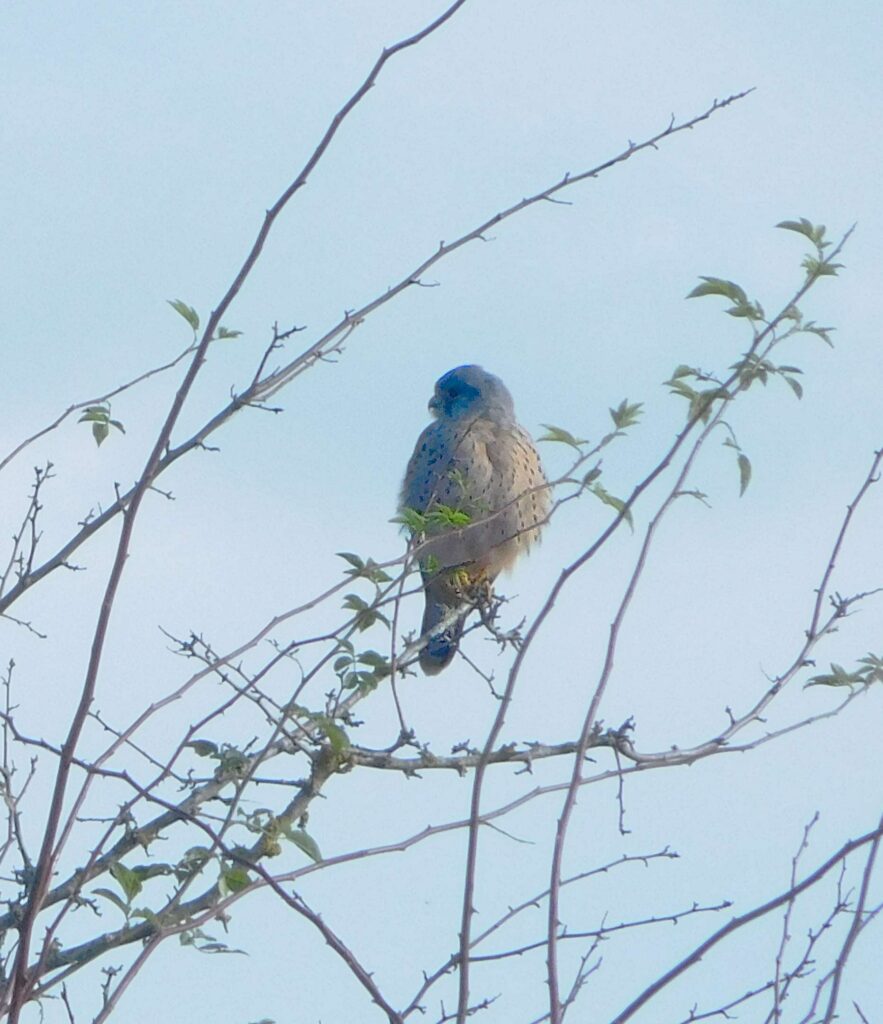







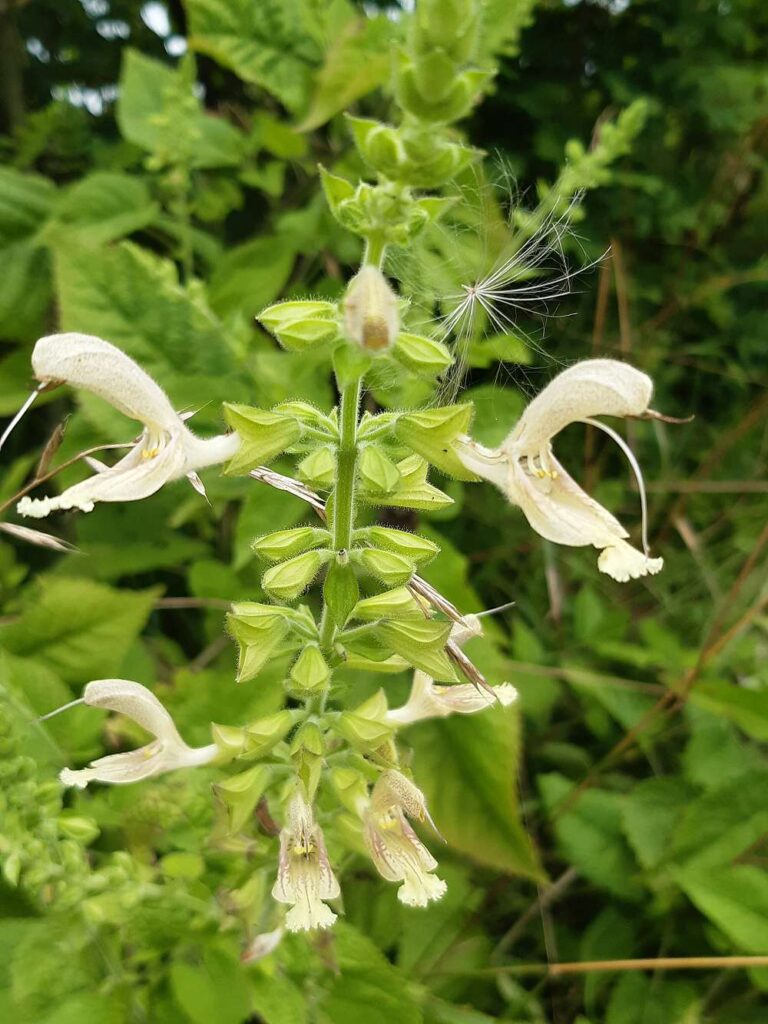
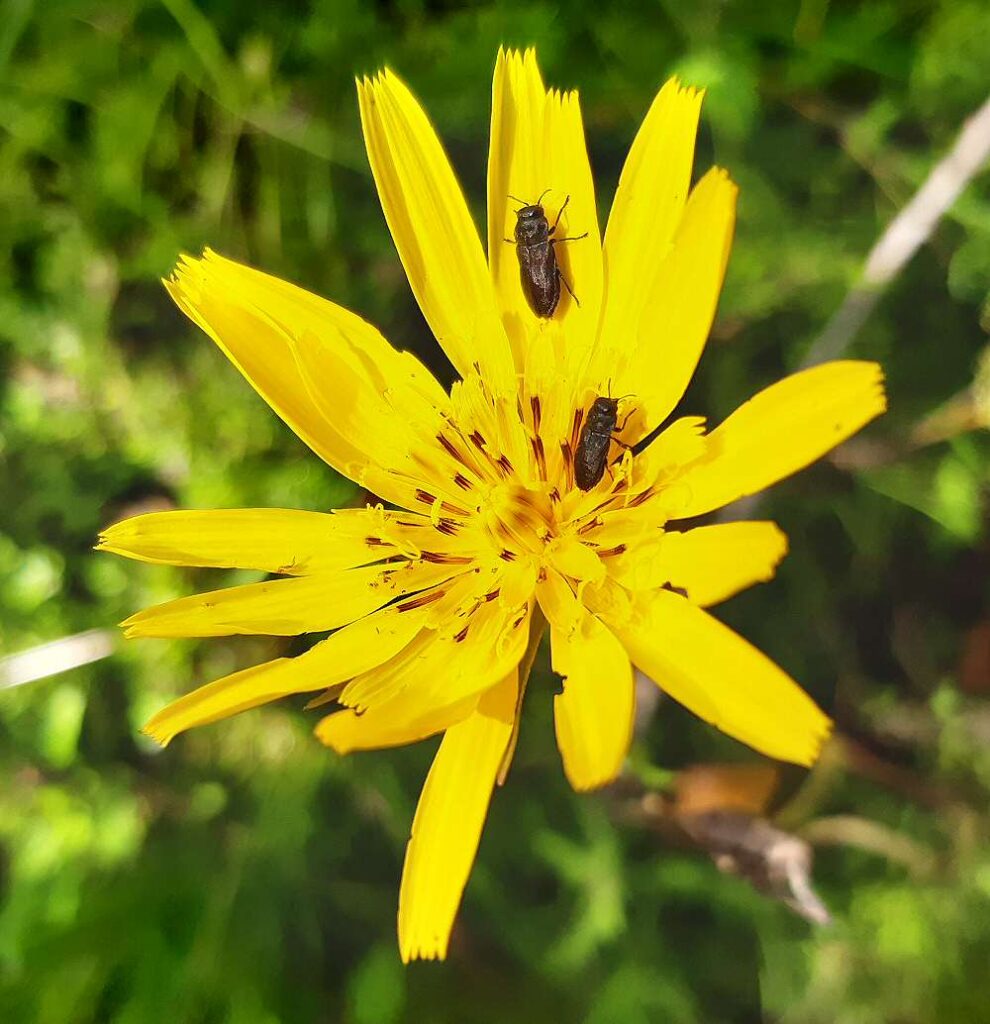


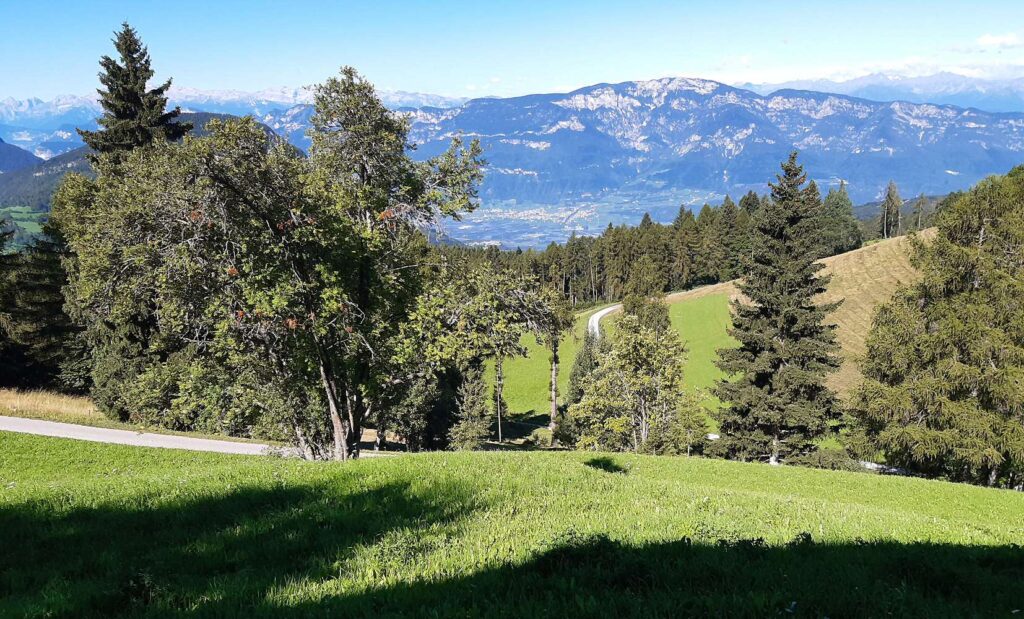

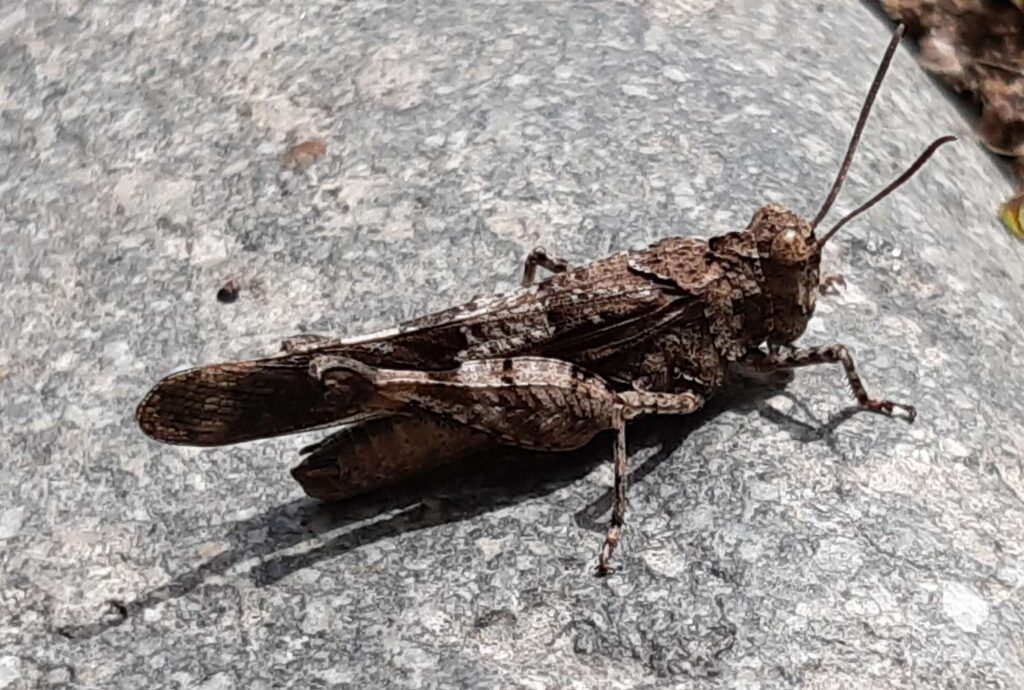
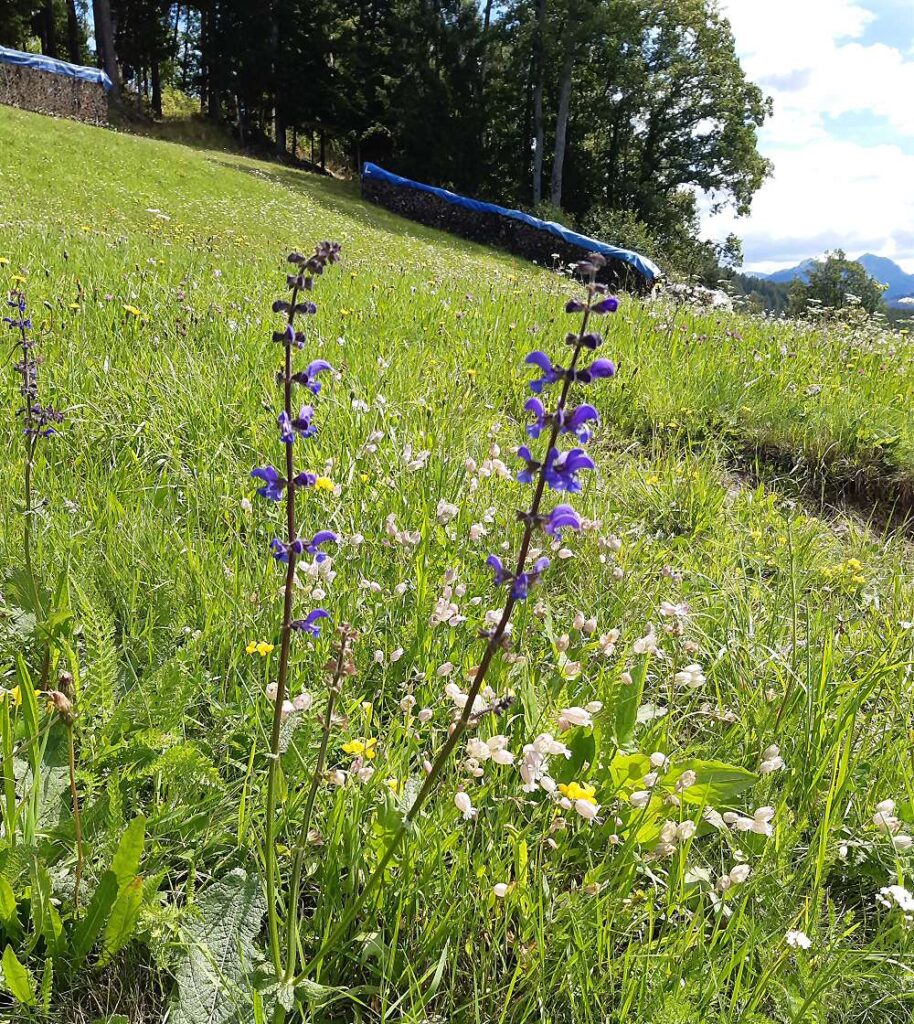





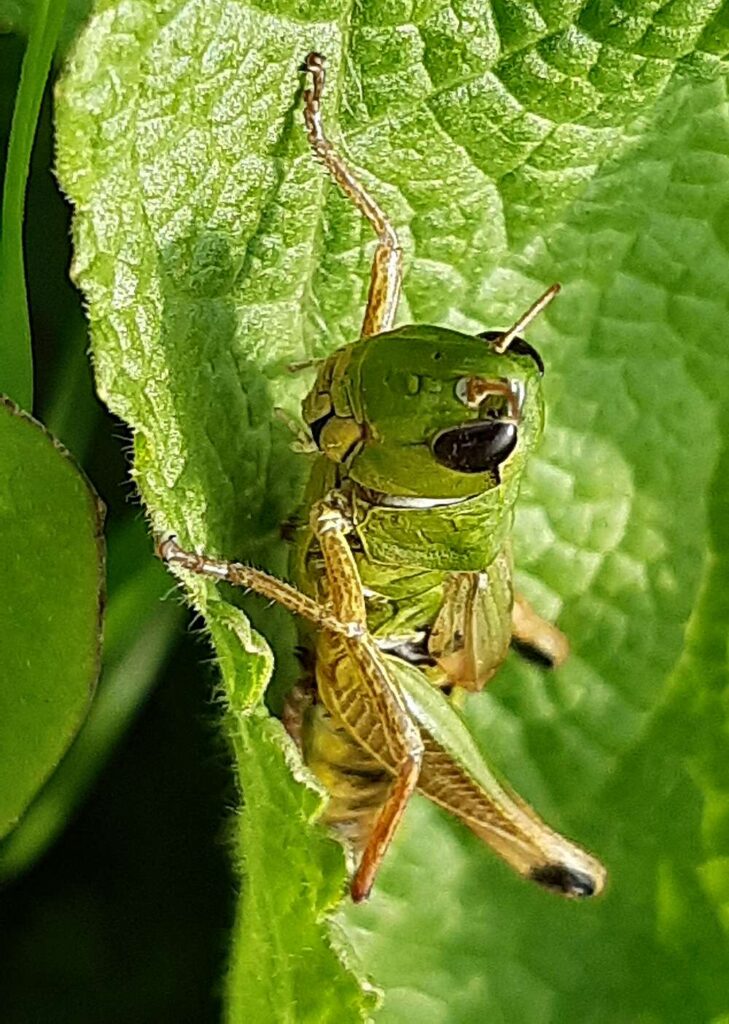


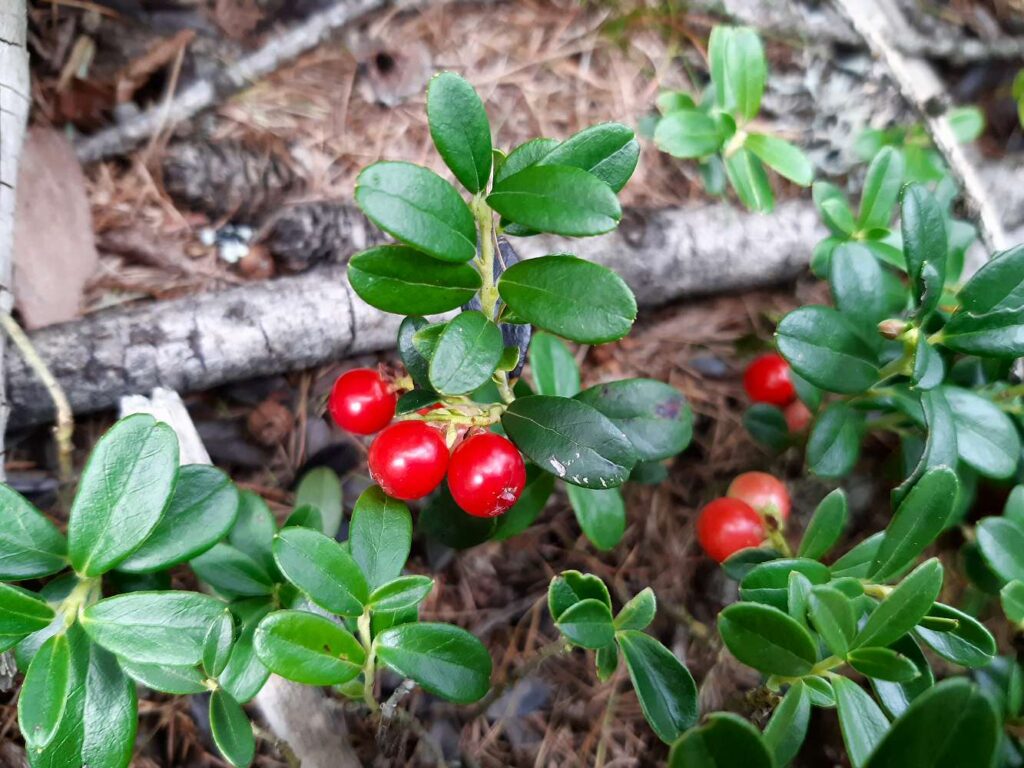
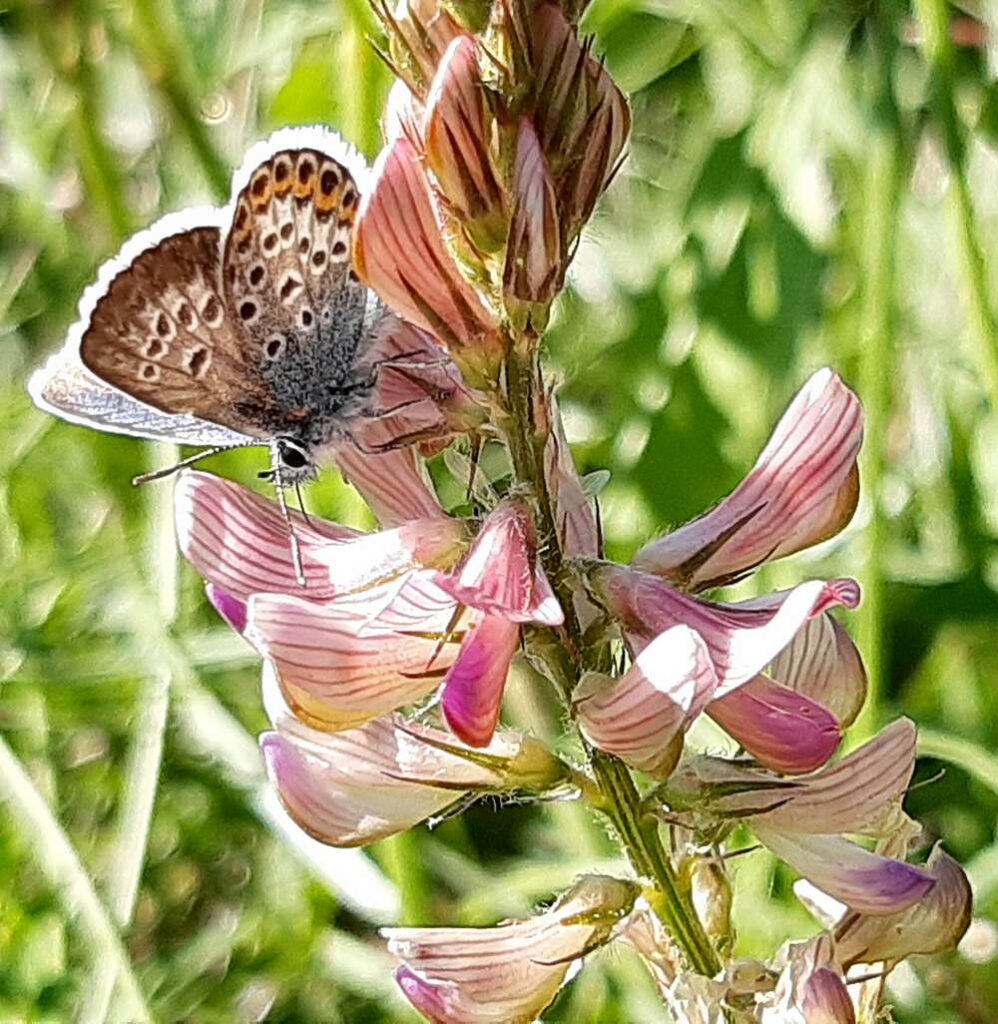

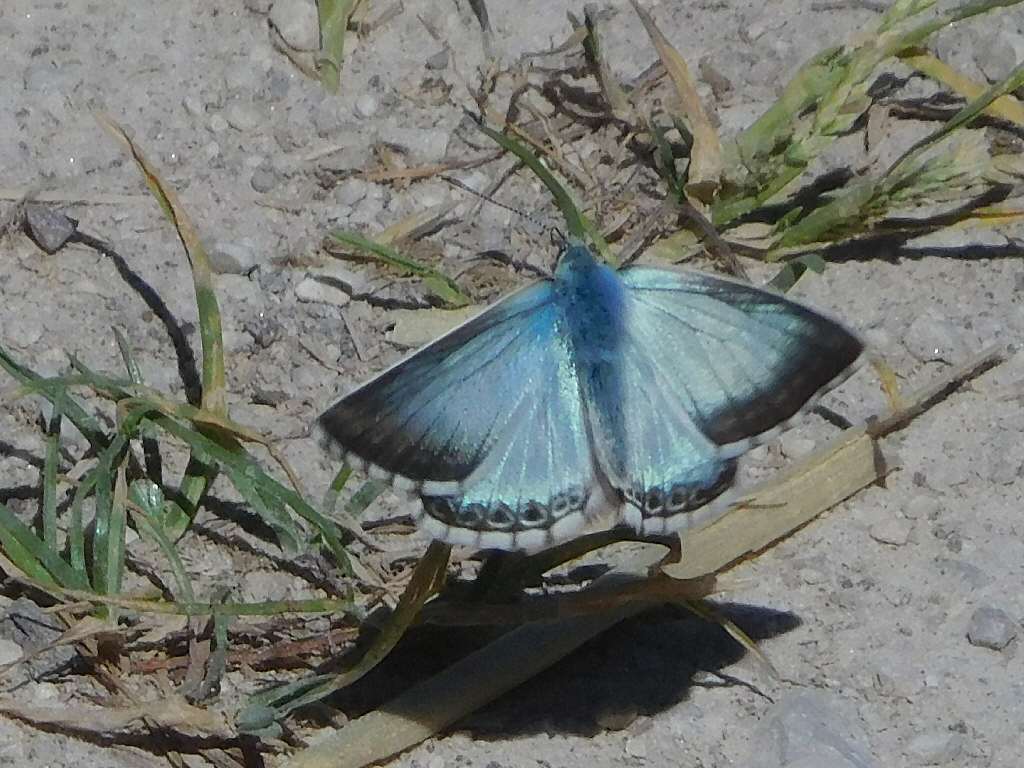
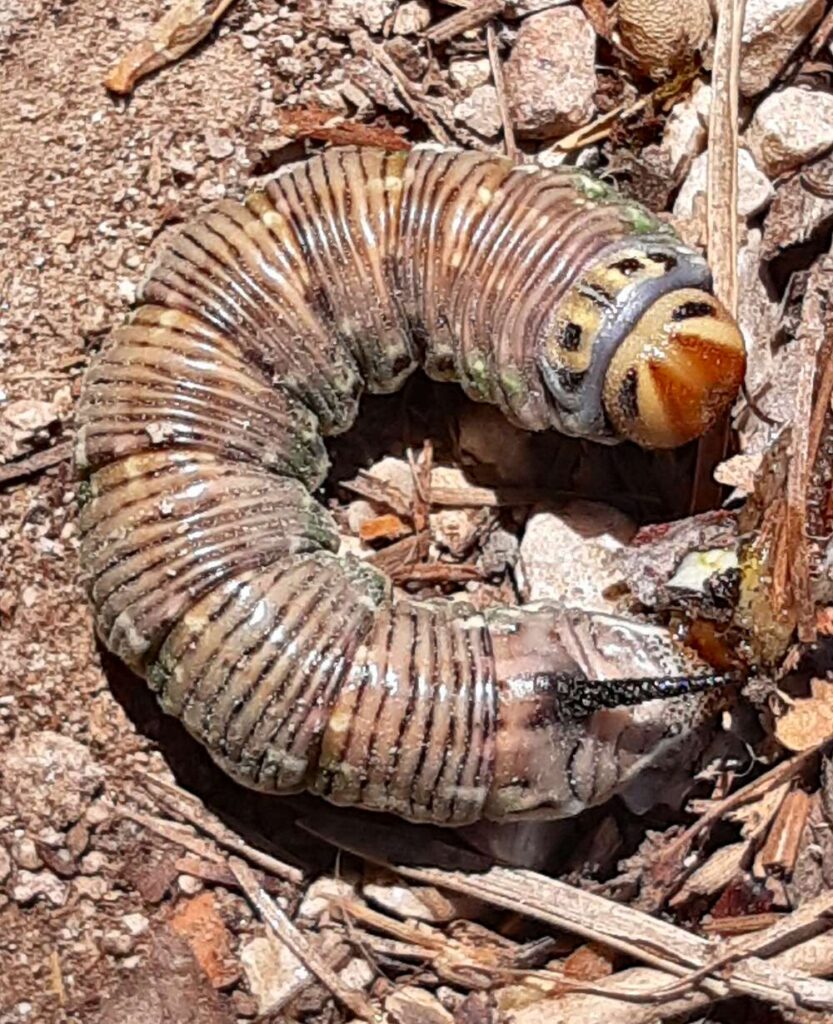
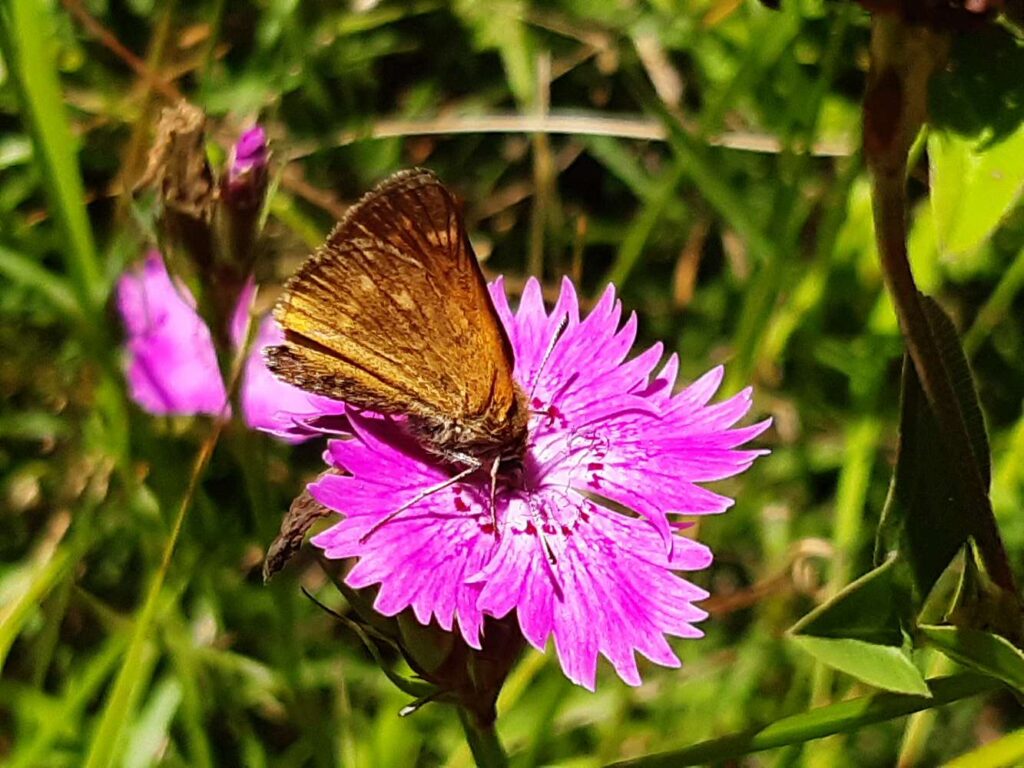




A Kestrel hovered persistently in the steady breeze, starting above treetop height and dropping lower in little steps, over the rough grass full of thistles, burdock, and teasels

Comfrey, once used as a medicinal herb to knit bones, still in flower in October. A solitary Chiffchaff sang its simple song nearby.

Germander Speedwell, a miniature beauty in bloom
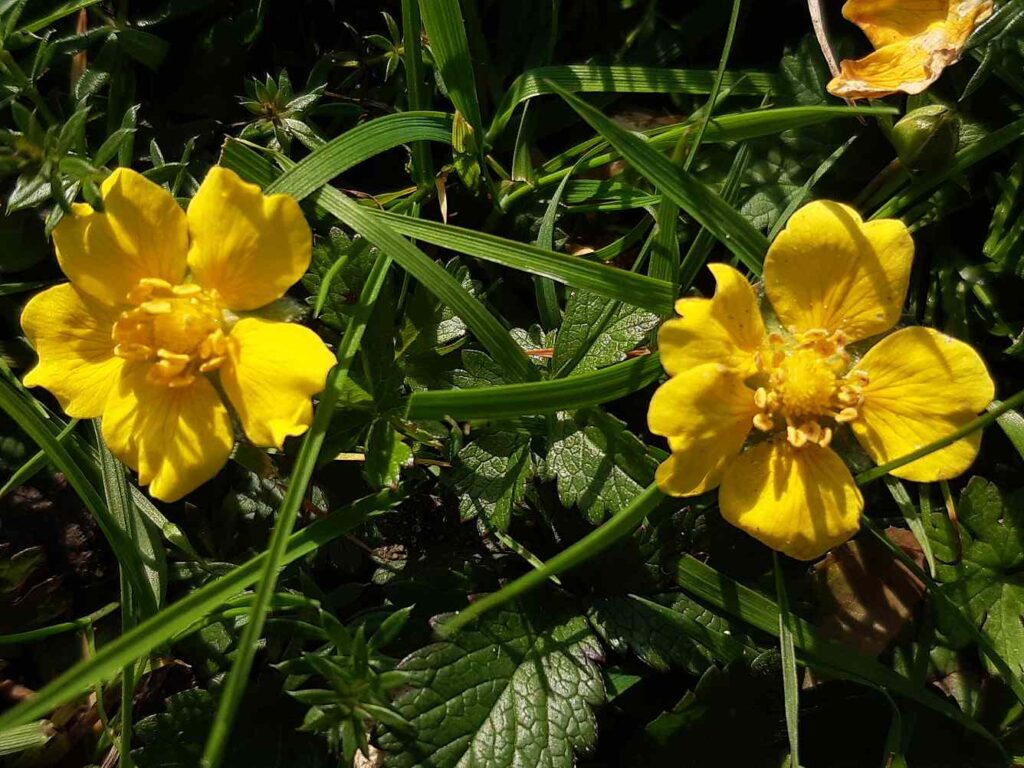
Creeping Cinquefoil, an attractively bright flower in clusters among the well-trodden grass of the path

The extraordinary pink of the fruit of the Spindle Tree, a small slender tree with long and extremely straight twigs, that were ideal for medieval spinsters to use as spindles when spinning thread
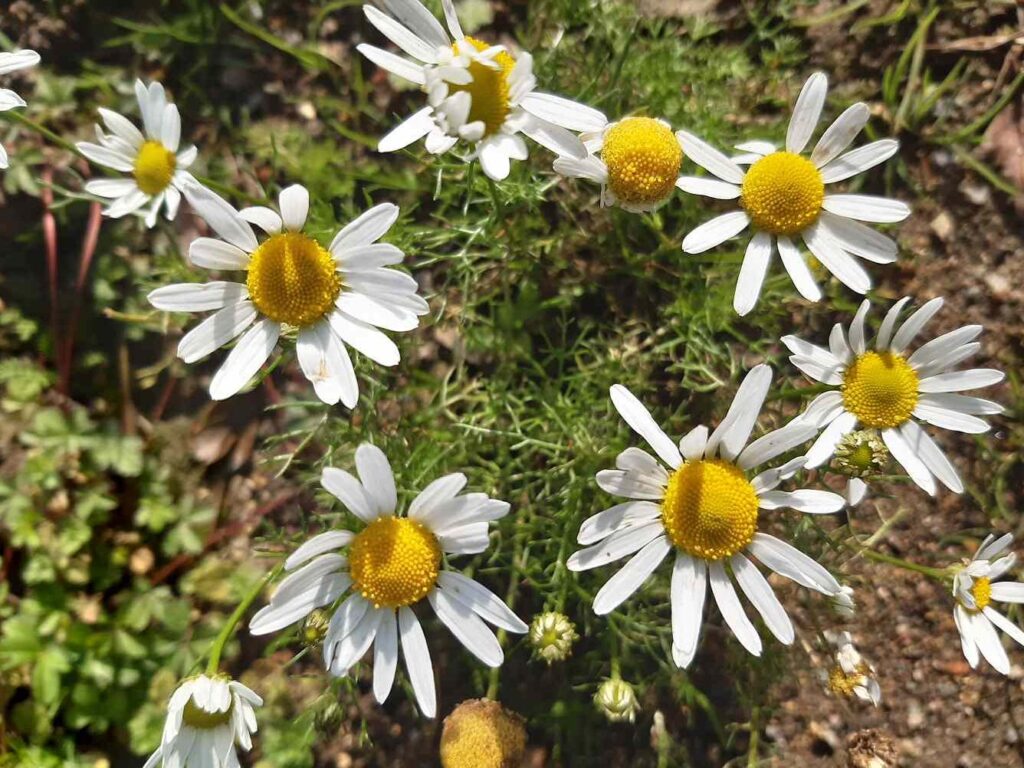
Scentless Mayweed, a cheerful flower of waste ground, common in the pony field. A twittering flock of Linnets flew into a bramble patch in the field, perching atop the bush and making little flights, apparently catching insects, before returning to their perches.
I’d hardly stepped onto the path before a pair of Peacock butterflies spiralled up in a territorial dispute – the little meadow was evidently prime habitat, and the males were fully charged up on this beautiful spring day.

A bit further along, a Small Tortoiseshell was visiting some of the many Dandelions by the path. It’s certainly my first this year; and I can’t recall seeing one here at Wraysbury before. It was once a common butterfly but nowadays unkempt beds of Nettles are rare enough, and like all our showier butterflies, they’ve suffered from the changes to the countryside, including insecticide sprays.

The next delight was the first Orange-Tip of the year. It’s a “White” butterfly but with beautiful coloration above and below: the underwing is remarkably well camouflaged.
In a woodland glade, two Commas tussled for the best display position.

And near one of the lakes, an Alder-Fly clambered along a twig. The larvae are aquatic; on a good day in early summer, the air can be full of adult Alder-Flies.
Birdsong was pretty much continuous, with Blackcaps, Chiffchaffs, Great Tits, Song Thrushes, Blackbirds, Green Woodpeckers, a Cetti’s Warbler and I think a Sedge Warbler too all contributing their songs. A Heron gave a harsh croak and some ungainly squawks. A Parakeet shrieked overhead. A Kestrel hunted silently. Spring has sprung in Wraysbury.

Winter showed her wizened hand today. The bright sunshine of the morning quickly gave way to cloud under a chilly northerly wind. Zipping up my coat, I wondered if I’d see anything worth remarking, and plodded up the path in the flat light. I looked left at the river Colne, and a plump Water Vole splash-dived among some juicy Iris leaves that I guess it had been cutting. Once a common enough sighting, it’s now something very special.
The main lake was almost devoid of birds, a distant swan, a few black-headed gulls and a coot or two more or less summing it up, a dull day (apart from the vole). I rounded a bend and came face to face with a very fresh-faced, brightly-coloured fox. It stared at me for a glorious second, then turned tail and fled. Given the long narrow neck of land between the river and the lake, it must have run quite a way to escape.
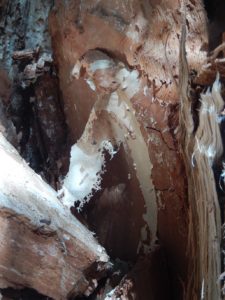
Not much further, a riverside willow had fallen on to an ancient hawthorn, forming a striking arch. The broken trunk was quite hollow, only a couple of inches of the newest wood remaining as a thin fragile tube. These large trees grow rapidly to a considerable size — and suddenly fall. The wood is soft, and it seems that saprophytic fungi (or perhaps parasitic) can speedily destroy it. This tree was layered with a dry papery sheet of whitish mycelium, presumably whatever species it was that rotted the trunk hollow.
A dark brown Buzzard, almost without markings, floated broad-winged just above the small lakeside trees, almost close enough to touch.
Beside me, the lake suddenly exploded into a mass of pattering feet on water, as a dozen Gadwall rushed to take off. Perhaps these newly-arrived birds are from the frozen north, unused to the slightest human disturbance.
The end of the lake held a score of Tufted Duck, their numbers too increasing rapidly now, again presumably from colder lands to the north or east.
At the steel bridge, a Bullfinch repeated its insistent call, Deu, Deu. And over the grassy meadow, a Kestrel floated silently, hovered, drifted effortlessly upwind to hover again.
Indian Summer days are delightful, but often not terribly rich in visible wildlife – this year’s young have fledged and left the nest; flowers have faded and gone into fruit (which can be beautiful, of course); butterflies and dragonflies have mostly stopped flying; summer birds have left for Africa; and the warm calm air doesn’t bring winter migrants from the frozen North.
But there was plenty to listen to this morning.
As I walked in off the road, a Heron took off behind the bushes, and gave a two-tone ‘cronk’ note as it flapped off over the lake. I peered through a gap, and there it was, its amazingly broad angled wings like an ingeniously light balsa wood and doped muslin flying machine, totally unlike the awkward folded umbrella of an ungainly bird that a Heron is when perched.
Two Mute Swans took off and flew low over the water right in front of me, as silent as their name: only their wings whistling with each heavy wingbeat.
A solitary Cormorant took off from the water, very black without the white breeding season thigh patches, also silent except for the heavy thwack of its feet slapping the water on the first ten wingbeats.
A Cetti’s Warbler, invisible in the waterside bushes as always, burst into its loud rude song. (Once you’ve read Barnes’s description of just how rude that is, in How to Be a Bad Birdwatcher, you’ll never hear a Cetti’s without smiling again, I promise.)
A Green Woodpecker gave its cheerful triple signature call, somewhere far out of sight. No need to look.
A few Long-Tailed Tits called anxiously to each other, ‘Tsirrup’, high in the willows. I couldn’t see them either, and again, I didn’t mind a bit.
Bizarrely (and this was a sight to behold, perhaps the only one of the walk), 4 Cormorants took to the air, seeming to be chasing 4 young Herons, presumably a family party.
Up on the horses’ hill, a Kestrel hovered silently on whirring wings.
The horses won’t be there much longer: Affinity Water have put up little notices To Whom It May Concern, saying they’ve had enough with ‘flygrazing’ (makes a change from flytipping, presumably) and will remove the horses if they’re not taken away. I suppose the gypsies have left them to breed as well as graze for free (there’s plenty of grass); the horses are always gentle, and do a good job of controlling the meadow, actually. Why would they do that, a friend wondered. I suggested that it made perfect sense – each year, the ‘owners’ could drop in, take a mare, and leave the others to keep up the supply of new horses. What an economical, ecological system. Without the horses, I guess someone will have to pay for mowing, or maybe they’ll hire a flock of sheep for a few weeks each year? Not sure the horses aren’t a better solution. Of course they could leave some goats to go feral. (Only kidding.)

Spring is full of surprises, and this Heron, nesting not in a colony up in the trees, but all alone in an abandoned Swan’s nest in a reedbed, is certainly one of them. The London Wetland Centre this morning also boasted a mass of Blackcaps in the “Wildside” woodland, with at least three males and a female actually in sight at once, along with an obliging Chiffchaff giving me an excellent view, and a characteristically invisible Cetti’s Warbler, shouting out its amazingly loud call. The Silver Birches were in wonderfully fresh green leaf, their bark crisply white against the clear blue of the sky.

Yesterday, round at Wraysbury Lakes, the same set of three warblers sang, but more elusively. The most delightful surprise was a Treecreeper, not only creeping up the willow branches, but singing its sweetly plaintive little song. This used to be rendered, rather tweely, as “Tree, tree, tree, once more I come to thee”, which does capture the length and rhythm of the song. It is not unlike the Chaffinch’s song, if you know that, but without the twiddly “tissy-cheeooo” ending, and not so firm and harsh. One of the Blackcaps, in the thorn-scrub area, had a fine mimetic song. Out on Horse Hill, the first two Swallows of the year flitted overhead, a solitary Kestrel beat its way against the wind, and half a dozen Jackdaws played and chased in the air, for all the world like a gang of naughty schoolboys.

After the bitter cold of the New Year, down to a surprising -12C in London, suddenly spring (as it were) is back in the air, and the Daffodils are resuming their progress towards full bloom in gardens and on roadsides.
The warmth and sunshine tempted me out to Wraysbury. With the heavy rain and perhaps also the rapid changes of temperature, a large Poplar had fallen across the river, forming a minor weir.
On the path, a Muntjac deer had left its tiny prints in the soft mud. Unlike a lot of other mammals, at least this one is readily identifiable from its print, the two small sharp slots of its slim feet not mistakable for anything else.
The lake, which had been full of birds as big as Swans last time I visited, was almost empty: a few Coots, some Great Crested Grebes, a Black-Headed Gull, a few roosting Cormorants, a few Tufted: and happily two of the area’s specialities, three pairs of Goosander, and nine Goldeneye (including three males).
A Kestrel hovered and dropped slowly after a small mammal in the long grass. A Redwing flickered away around a corner. A Song Thrush sang sweetly from a thicket. One or perhaps two Bullfinches gave their distinctive “Deu” call from the middle of a bush. Half-a-dozen Fieldfares chattered and skittered about from the top of one bare thornbush to another. A few Wood pigeons and Crows looked out warily.
The woods of Richmond Park were full of Jackdaws, constantly jostling for whatever position Jackdaws have in their noisy gangs. And the even noisier squawkings and screeches of the Ring-Necked Parakeets, of course, high in the trees or dashing about.
Out on the quieter grassland and bracken, now dry and brown, a Stonechat perched on a prominent lookout, its red breast, white collar and dark head distinctive.
A Kestrel drifted past, tail fanned, its handsome rufous back and dark wingtips characteristic; it turned and powered the other way, flew all across the open space over the anthilly grassland, and rose into a distant tree.
The upper Pen Pond had at least 6 Mandarin Ducks, the males ridiculously decorative, dressed like dandies and constantly showing off, alongside a few Pochard.
The lower Pen Pond had perhaps 30 Gadwall, a dozen Wigeon, a few Tufted Duck, and – best bird by far – a single Snipe that got up from the water’s edge near my feet, called ‘Creech’ once, and zigzagged rapidly off across the water, up and over the trees and the upper pond.

It was suddenly summer again this morning, so I packed cameras, binoculars and a sandwich and went down to Thursley in glittering sunshine. This photo perhaps catches something of the dazzle and sparkle of the bog pools and their shimmering guardians: a pair of Keeled Skimmers (Orthetrum coerulescens) are flying over the water; she is darting down to lay eggs, he is hovering above, guarding her from other males. Their wings sparkle and flash, and it is amazingly difficult to follow, frame, focus and shoot fast enough to get anything like a decent picture. But I rather like the motion blur in this one, and if it’s not perfectly in focus, you know why. I hope you like it too.
I was pleased, too, with this shot of an Emerald Damselfly, the sparkling water behind it forming a pattern of pleasantly out-of-focus circles.
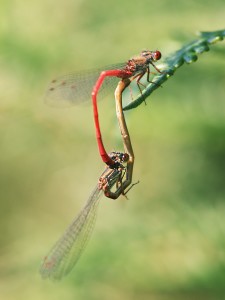
There were quite a few Small Red Damselflies about, mostly single but a few egg-laying pairs; and a modest number of blues, most likely Azures.
Apart from the hundreds of Keeled Skimmers, other dragonflies included Common Darter, Black Darter (I only saw a few females today), Black-Tailed Skimmer (just one), and Southern Hawker.
We saw few butterflies apart from Large Skippers which bustled about flowers near the boardwalk, and little Gatekeepers (I do mean they were smaller than usual) … until we arrived on the amazing Parish Meadow that was once a dump for emptying cesspits. Now it has an ecology strikingly unlike the rest of Thursley Common.
The meadow was full of Meadow Browns, Graylings (mating), Ringlets, Essex Skippers, a Brimstone, Large and Small Whites, and … a Purple Hairstreak (about the Oak trees). The rabbit-bitten pasture, dotted with little flower-stalks of Centaury, was thick with Ragwort, which in turn was richly covered with Cantharid beetles, solitary bees, wasps, and hoverflies and other Diptera. We put up a Silver Y moth which obligingly landed in front of us and perched in the open. We found the traces of a Green Woodpecker killed by a Sparrowhawk; but happily saw a live one in the Oaks nearby.


The boardwalks were busy with Lizards and Skimmers sunning themselves.
We met a local group of birders, complete with masses of tripods, telescopes and cameras, and asked if they were looking at the Stonechats. No, they replied, the Hobbies, there are three. We looked up, and sure enough there were three raptors. But in our binoculars, they turned out to be a Kestrel, a Hobby, and a Red Kite! Perhaps there were some more Hobbies somewhere else.
A little way further, absent the birders, we found a dead tree with some juvenile birds perched about it, and a lot of twittering. Yeah, a typical Chiswick Cafe. Some of them were young Redstarts; the others, young Stonechats: pretty confusing. But the Redstarts flew up into a Pine tree – not a Stonechatty thing to do – and sure enough, there was an adult Redstart on a lower branch, plain to see. And a Stonechat adult rasped out its grating call over to the right.
In a group of tall Oaks, we sat and ate a sandwich; and a Spotted Flycatcher flew across and perched on a high dead branch. It spent five minutes looking about, twisting its neck remarkably, but making no sallies. When I was a boy I saw them in the garden every summer; now they’re really something special, like, er, Starlings and House Sparrows.
The sandy heath paths were full of little holes dug by Ammophila Sand-Wasps, and others made by Philanthus Bee-Wolves (or Bee-Killer Wasps). Both are called digger wasps (“Sphecidae”) in most books, and it’s certainly a good name, but the family has been split up, so Philanthus is now in the Crabronidae, which contains most of the old “Sphecidae” (we’ll have to say sensu lato for this); the new Sphecidae (sensu stricto) only contains what used to be the Sphecinae, which includes Ammophila. Rich scope for confusion. Sphex is the ancient Greek word for wasp, and it’s interesting that Linnaeus chose this word for a digger wasp rather than the social wasps, which have the Latin name Vespa for the hornet, and Vespula, little wasp, for common wasps.
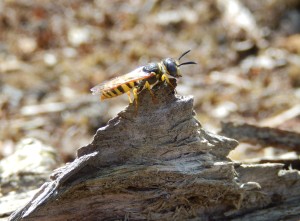


Out of a low bush of willow and gorse right beside a boardwalk came a strange, quiet but insistent squawky chatter of alarm. Peering in between the branches, a small slim dark bird with a long dark tail could be seen hopping about anxiously: a Dartford Warbler. It was extraordinary to be within a few feet of this shy, rare and retiring bird, and watching it for several minutes. There are actually quite a few on the heaths of Surrey and the south coast, but they’re never easy to see—most of my views have been of disappearing rear ends, diving into gorse bushes.